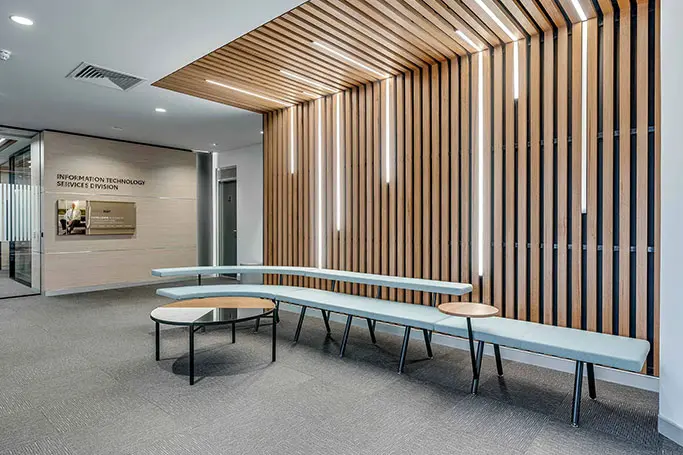Timber walls are making a strong comeback in contemporary interior design, adding warmth, texture, and a touch of nature to modern spaces. With their versatility and timeless appeal, timber feature walls and timber cladding are being embraced by designers and homeowners alike. This blog explores the innovative ways timber walls can be incorporated into contemporary interiors, offering a range of aesthetic and functional benefits.
The Allure of Timber Feature Walls
Creating Focal Points
A timber feature wall can transform an ordinary room into a stunning visual masterpiece. By drawing the eye to a specific area, it creates a focal point that adds depth and interest to the space. Whether it’s a living room, bedroom, or office, a timber feature wall can enhance the overall design and make the room feel more inviting.
Enhancing Texture and Warmth
Timber walls bring an element of texture that is often lacking in contemporary design. The natural grain and variation in timber add a tactile quality that contrasts beautifully with smooth, modern surfaces. This texture not only enriches the visual appeal but also introduces a sense of warmth and comfort, making interiors feel more cosy and welcoming.
Versatility in Design
Timber feature walls offer incredible versatility in terms of design. They can be customised to fit various styles, from rustic and traditional to sleek and modern. By choosing different types of timber, finishes, and installation patterns, designers can create unique looks that complement the overall aesthetic of the space. For instance, a wall clad in reclaimed wood can add a rustic charm, while a wall with smooth, polished timber panels can exude contemporary elegance.
Timber Cladding: A Modern Twist on a Classic Element
Innovative Applications
Timber cladding is not just for exteriors anymore. Its use in interior spaces has opened up new possibilities for creative design. Timber cladding can be applied to entire walls, sections, or even ceilings, offering a seamless integration of natural elements into modern interiors. This approach can be particularly effective in open-plan spaces, where it can help define different areas while maintaining a cohesive look.
Sustainable and Eco-Friendly
Incorporating timber walls into contemporary design is also a sustainable choice. Timber is a renewable resource, and when sourced responsibly, it has a much lower environmental impact compared to other building materials. The use of timber cladding can contribute to green building certifications and demonstrate a commitment to sustainability. Additionally, timber’s natural insulating properties can improve energy efficiency, making spaces more comfortable and reducing heating and cooling costs.
Aesthetic Flexibility
The aesthetic flexibility of timber cladding allows for a wide range of design expressions. Horizontal and vertical installations create different visual effects, while various profiles and textures can be used to achieve the desired look. For example, vertical timber cladding can make a room appear taller, while horizontal cladding can add a sense of width and spaciousness. Combining timber cladding with other materials like glass, steel, or concrete can further enhance the contemporary feel, adding contrast and sophistication.
Practical Benefits of Timber Walls
Acoustic Properties
Timber walls are not only beautiful but also functional. One of the practical benefits of timber is its acoustic properties. Timber can absorb sound, reducing noise levels and creating a more peaceful environment. This makes timber feature walls an excellent choice for spaces where acoustics are important, such as offices, living rooms, and bedrooms.
Durability and Maintenance
Timber is a durable material that can withstand the test of time when properly maintained. Advances in timber treatments and finishes have improved its resistance to moisture, insects, and wear, making it suitable for various interior applications. Regular cleaning and occasional re-finishing can keep timber walls looking their best for years to come. Moreover, the natural aging process of timber can add character and charm, making it even more appealing over time.
Design Inspirations for Timber Walls
Scandinavian Minimalism
Scandinavian design is known for its minimalist approach and use of natural materials. Incorporating timber feature walls into a Scandinavian-inspired interior can enhance the sense of simplicity and elegance. Light-coloured timber with a smooth finish can create a serene backdrop, allowing other design elements to stand out. Pairing timber walls with neutral tones, clean lines, and functional furniture can achieve the quintessential Scandinavian look.
Industrial Chic
In industrial-style interiors, timber feature walls can add a touch of warmth and balance to the raw, unfinished look. Combining timber with exposed brick, metal, and concrete can create a harmonious blend of natural and industrial elements. Darker timber finishes can enhance the rugged aesthetic, while lighter tones can provide a softer contrast.
Contemporary Elegance
For a more refined and sophisticated look, timber cladding can be used to create sleek, elegant interiors. Dark, polished timber with rich grains can add a luxurious feel to living rooms, dining areas, and bedrooms. Incorporating built-in lighting within the timber cladding can highlight its natural beauty and create a dramatic effect. This approach works well in contemporary homes, hotels, and upscale commercial spaces.
Rustic Retreat
Timber walls can also be used to create a rustic, cabin-like atmosphere in contemporary settings. Using reclaimed wood with its natural imperfections and weathered look can add character and charm. This style is perfect for creating cosy, inviting spaces that feel like a retreat from the hustle and bustle of everyday life. Combining timber walls with plush textiles, warm lighting, and nature-inspired décor can complete the rustic retreat aesthetic.
Conclusion
Timber walls offer a unique blend of aesthetic and practical benefits, making them an excellent choice for contemporary interior design. Whether used as feature walls or as part of timber cladding, they bring natural beauty, warmth, and versatility to any space. With the right design approach, timber walls can transform interiors, creating environments that are not only visually stunning but also comfortable and functional. Embracing timber in modern design is a testament to the timeless appeal and enduring quality of this natural material.

